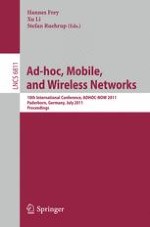2011 | Book
Ad-hoc, Mobile, and Wireless Networks
10th International Conference, ADHOC-NOW 2011, Paderborn, Germany, July 18-20, 2011. Proceedings
Editors: Hannes Frey, Xu Li, Stefan Ruehrup
Publisher: Springer Berlin Heidelberg
Book Series : Lecture Notes in Computer Science
